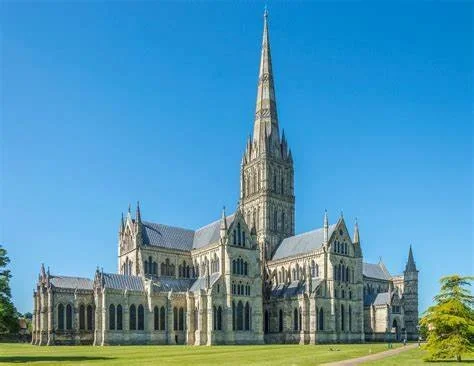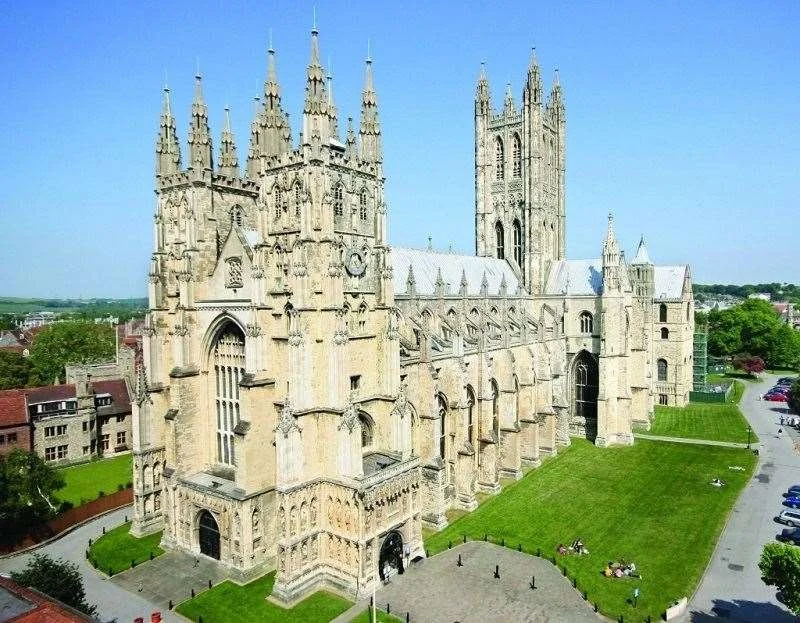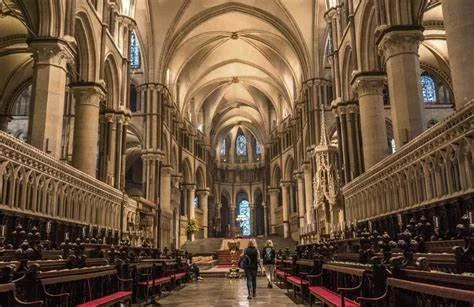Cathedrals: London and the South
“Winchester Cathedral, you’re getting me down,
You stood and you watched as
My baby left town!”
They don’t write them like that any longer! Thank goodness, we may say.
This was a hit song in 1966 by the New Vaudeville Band, and is by way of introduction to Part 4 of my perusal of British Cathedrals, most of which I have sung in. In the last part, we had reached deepest Cornwall, with the Victorian splendour of Truro Cathedral, and now, it’s time to turn eastwards again, heading for the capital, with its three cathedrals, one abbey and two outriders.
Salisbury Cathedral
Before we reach Winchester however, we discover the wonder that is Salisbury Cathedral, apparently beloved of Russian secret agents. I have sung there a couple of times, and Fran has also lent her voice to its superb acoustic, singing in the Philharmonia Chorus in Mahler’s 8th Symphony!
The foundation stones were laid in 1220, and, by 1258, most of the building was complete. The cloisters, chapter house, tower and spire were all added soon after, and by 1320 the cathedral we see now was finished. It was an extraordinary feat of building, and resulted in a most homogenous church, all in early Gothic style. Maybe with the example of Stonehenge only a few miles away, the masons were unconsciously vying with their prehistoric ancestors to create another wonder.
The cathedral dominates the small town of Salisbury, and its spire at 404 ft tall is the highest in Britain. Together with the tower, it added over 6000 tons to the weight of the building, and without buttressing it would have fallen down years ago. In 1668 Sir Christopher Wren added reinforcing tie-beams above the crossing, hidden by a false ceiling, to give added support.
The ancient clock, dating from around 1386, is thought to be the oldest working clock in the world. It had been stored and forgotten about for decades until its discovery in an attic in 1928, and after cleaning and restoring, it now sits and keeps time in the cathedral, to visitors’ amazement. In the chapter house is kept the best preserved of the four remaining copies of the Magna Carta, the Great Charter of Freedoms signed by King John and his unruly barons in 1215 at Runnymede. Two are in the British Library, and the fourth is in Lincoln Cathedral, where we started out journey round the cathedrals.
Salisbury Cathedral
Fran’s Mahler 8 was special for many reasons, not least for the appearance of the soprano singing Mater Gloriosa, high up by the great West Window. It was a wonderful effect in a wonderful performance of a wonderful work! There was a possibility of me singing the bass solo a few years ago, but, having studied it for a day or two, I realised that it needs an even bigger voice than mine, and reluctantly, I decided not to sing it. It’s really heavily orchestrated, and I must say, in concert, the voice is often overwhelmed by the orchestra. Mahler has form in this department, as the tenor in ‘Das Lied von der Erde’ is usually drowned out by the orchestra, especially in the first song. I was in the Festival Hall when Jessye Norman and Jon Vickers sang Das Lied in the early 80s, with Colin Davis conducting. Now, Jon Vickers had the loudest tenor voice I have ever heard, but even he was largely inaudible. If only Mahler had lived a little longer to hear his composition, I’m sure he would have changed the orchestration.
Winchester Cathedral
Moving east again, we do now arrive at Winchester Cathedral, another of the great English mediaeval buildings which glow like beacons in our modern world. Built between 1079 and 1532, it is the longest mediaeval cathedral in the world at 558 ft, and one of the finest. We used to have good friends who lived in Winchester, and we were regular visitors, but they moved to Cheltenham in the 1980s, and we haven’t been back. I must rectify this omission. By the way, Jane Austen was closely associated with Winchester, and was buried in the north aisle in 1817. Why Winchester featured in the song quoted above is a mystery. The composer, Geoff Stephens, died in 2020, so we may never know. It was covered by Frank Sinatra, a version I haven’t heard, and probably should continue to avoid!
Chichester Cathedral
Chichester Cathedral, another of those English cathedrals in tiny places, is a fine Norman and Gothic building, consecrated in 1108. As I have remarked elsewhere in this chapter, the arrival of the Normans in 1066 sparked a creative surge, the like of which we have never seen before or since. What the conquered Anglo-Saxon peasants made of this extraordinary building craze is unknown, but the change from small wooden or stone churches on a very modest scale after the arrival of Christianity in Britain around 600 AD, to the preponderance of these enormous stone structures from 1066 on, is mind-boggling.
Chichester is a fine example of cathedral building, in a town whose entire population could be fitted easily into its interior! The most unusual feature of Chichester is its free-standing bell tower, or campanile, typical of Italian cathedrals but rare in England. It seems that Chichester towers had a habit of falling down, so a bell tower some distance away was probably a wise move. The south west tower collapsed in 1210, and was rebuilt, and the north west one collapsed in 1635 (rebuilt only in 1901). In 1861, the central spire collapsed completely, but was rebuilt by George Gilbert Scott, that most active of architects in the 19th century.
Canterbury Cathedral
Skirting London, and its outliers Guildford and St Albans, we reach Canterbury in Kent, almost exactly where William the Conqueror arrived in 1066, defeating King Harold at the famous Battle of Hastings. The last foreign invader of the British Isles was a terrifying figure, also known as William the Bastard (you can see why he preferred “The Conqueror”!), a direct descendent of the Viking warriors who had swept down from Scandinavia a few centuries before.
Canterbury was one of the earliest cathedrals established in England. Pope Gregory 1 had sent Augustine on a mission to convert the Anglo-Saxons of England, and his mission began with the founding of Canterbury Cathedral in 597. Various buildings replaced each other until a fire in 1067, the year after the Conquest, destroyed the old church. A new one was begun in 1070, overseen by the first Norman Archbishop, Lanfranc, who used the design of the Abbey of St Etienne in Caen. Dedicated in 1077, another extraordinary example of Norman efficiency, it forms the basis of the cathedral now. In 1170, Archbishop Thomas Becket was murdered by knights of Henry II, and with the declaration of his martyrdom, Canterbury became a place of pilgrimage, in addition to being the home of the most important archbishop in England. Chaucer’s Canterbury Tales (1387-1400) describe the stories of a group of pilgrims en route to Becket’s shrine. In 1174, another fire destroyed the east end, and a new choir and shrine were constructed, completed in 1184, although Becket’s remains were only transferred from the crypt in 1220. In the late 14th century, the nave and the transepts were rebuilt in the Gothic Perpendicular style, and so, the cathedral became a monument to changing architectural styles. Damage and vandalism occurred during the Reformation, including the destruction of Becket’s shrine, on the orders of Henry VIII, but the cathedral remains as the home of the Primate of England, to this day.
I was able to sing twice in the cathedral in the early 1990s, in two of the finest concerts I have ever been involved in. Both featured the local choral society and a fabulous scratch orchestra, sourced from Kent and London, who were conducted by David Hill. I sang Mephistopheles in Berlioz’ ‘La Damnation de Faust’ and Judas in Elgar’s ‘The Apostles’, two of the greatest oratorio bass parts. To sing the Devil in the cathedral was chilling enough, and to be part of the Wild Ride of demons towards the end was thrilling and terrifying in equal measure. Singing Judas, and portraying the arch villain of the New Testament, and yet trying to find sympathy for him, is always a difficult task, made all the trickier by the magnificent music that Elgar wrote. The phrase, the “devil gets the best tunes” is particularly apposite for both these roles!
I was back in Canterbury, singing the Ghost of Hamlet’s Father and the Gravedigger in Brett Dean’s ‘Hamlet’ in 2017 and reminded myself what a splendid building the cathedral is.
Guildford and St Alban’s
Our final cathedral destination is London, with its three cathedrals (St Paul’s, Southwark and Westminster Catholic Cathedral), Westminster Abbey, and the outliers, Guildford and St Alban’s.
The Diocese of Guildford was created in 1927, and the new Cathedral was founded in 1936. The Second World War and then financial delays prevented its opening until 1961 by the Queen. It was designed by Edward Maufe, and it must be said that the interior is a great advance on the exterior. Curvilinear Gothic is the name for the style, and it soars rather impressively. I sang there a couple of times and have memories of the decent acoustic.
Round to the north of London, St Alban’s Cathedral is one of England’s finest. Started in 1077, the year of the dedication of Canterbury, it was founded, as an abbey, by the nephew of Bishop Lanfranc of Canterbury, Paul of Caen. Most of the building is in the Norman Romanesque style, with Gothic additions, and was built to the same design as Canterbury, and therefore also, St Etienne in Caen. The great crossing tower is the only surviving Norman tower in existence, and the abbey church was finished in 1089 and consecrated in 1115, in a grand ceremony conducted by the Archbishop of Rouen and attended by Henry I and many Norman nobles. Much happened in the Abbey and the church over the centuries, and after the Dissolution of the Monasteries, the church was somewhat neglected. The creation of the Diocese of St Albans in 1877 led to the abbey church becoming a cathedral, subsequently much altered by the Victorians (the ubiquitous George Gilbert Scott, and then his son). It is a most impressive building. I sang my first Arvo Pärt ‘Passio’ there, before I sang it with the Hilliards, and another couple of excellent concerts later. There are some places where we sing which just feel good, and St Alban’s is one of them.
Westminster Catholic Cathedral and Abbey
I have only sung once in Westminster Catholic Cathedral, situated near Victoria Station, a service back in the 1970s with the St Andrews Renaissance Group, and I remember singing a motet by Thomas Weelkes in one of the longest echoes of any church I had sung in (only exceeded by Salzburg Cathedral, where we sang the same piece). The cathedral is in Neo-Byzantine style, and is quite breath-taking, in a slightly overwhelming way. Since its opening, many Byzantine mosaics have been added, originally in Arts and Crafts style, and these are very impressive. Unlike most Anglican cathedrals, there is no Choir section in front of the altar, but the choir is hidden away in a retro-choir apse behind the High Altar, contributing to the ethereal sound I remember. However, the fact that the organ is miles away from the choir resulted in tricky moments for us. As a useless fact, the first London performance of Elgar’s ‘Dream of Gerontius’ took place in the Cathedral in 1903.
Down the road at Westminster, is the famous Abbey Church, one of the most important churches in Britain. In the middle of the 11th century, King Edward the Confessor decided to rebuild the existing St Peter’s Abbey in Westminster as a royal burial church, thus beginning a tradition which has survived to this day. After the Norman Conquest, the abbey was the venue for William’s Coronation, recorded on the Bayeux Tapestry. Henry III began construction of a new building in Gothic style in 1245, as a suitable shrine for Edward the Confessor, and a resting place for himself. His own death brought some of the construction to a halt, but later additions were largely to augment Henry’s concept. It was briefly made a cathedral around the time of Henry VIII’s Dissolution, but eventually, Elizabeth I established Westminster as a “Royal Peculiar”, a Church of England church responsible directly to the Sovereign. It became the Collegiate Church of St Peter, with a chapter of canons headed by a dean. The two western towers were erected by Nicholas Hawksmoor in 1745, and apart from a few minor alterations and repair of bomb damage in 1941, the Abbey has remained the same to this day. It has become a hugely important burial church with many royal tombs and numerous tombs of the Great and the Good of Britain, and since William the Conqueror, virtually every English, and then British, monarch has been crowned in Westminster Abbey.
Westminster Abbey
It is an amazing place. I have never sung there, but I was lucky enough to be allowed to be present in the Choir stalls for a service in which one of my best friends’ sons became a full chorister, a lovely moment for all involved. Like most cathedrals nowadays, it costs a lot of money to get into Westminster as a tourist, but it is worth the price, as all these great buildings need constant supervision and restoration.
For the final part of this survey of cathedrals, we shall look at the two central London Anglican Cathedrals, Southwark and St Paul’s, which glower at each other over the Thames. I plan to round up with a quick look at continental cathedrals which I love. I started this chapter in Lincoln, my favourite British Cathedral, and will end with Chartres, my most-dearly loved French one!



